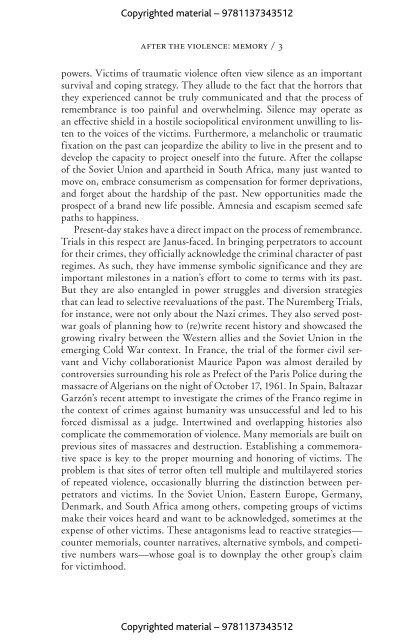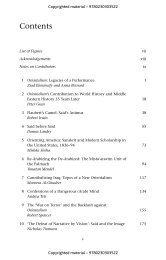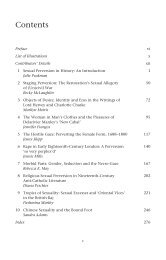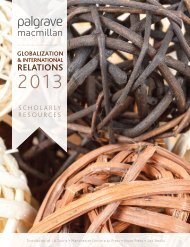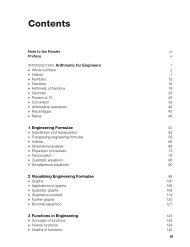Download sample chapter - Palgrave
Download sample chapter - Palgrave
Download sample chapter - Palgrave
You also want an ePaper? Increase the reach of your titles
YUMPU automatically turns print PDFs into web optimized ePapers that Google loves.
Copyrighted material – 9781137343512<br />
after the violence: memory / 3<br />
powers. Victims of traumatic violence often view silence as an important<br />
survival and coping strategy. They allude to the fact that the horrors that<br />
they experienced cannot be truly communicated and that the process of<br />
remembrance is too painful and overwhelming. Silence may operate as<br />
an effective shield in a hostile sociopolitical environment unwilling to listen<br />
to the voices of the victims. Furthermore, a melancholic or traumatic<br />
fixation on the past can jeopardize the ability to live in the present and to<br />
develop the capacity to project oneself into the future. After the collapse<br />
of the Soviet Union and apartheid in South Africa, many just wanted to<br />
move on, embrace consumerism as compensation for former deprivations,<br />
and forget about the hardship of the past. New opportunities made the<br />
prospect of a brand new life possible. Amnesia and escapism seemed safe<br />
paths to happiness.<br />
Present-day stakes have a direct impact on the process of remembrance.<br />
Trials in this respect are Janus-faced. In bringing perpetrators to account<br />
for their crimes, they officially acknowledge the criminal character of past<br />
regimes. As such, they have immense symbolic significance and they are<br />
important milestones in a nation’s effort to come to terms with its past.<br />
But they are also entangled in power struggles and diversion strategies<br />
that can lead to selective reevaluations of the past. The Nuremberg Trials,<br />
for instance, were not only about the Nazi crimes. They also served postwar<br />
goals of planning how to (re)write recent history and showcased the<br />
growing rivalry between the Western allies and the Soviet Union in the<br />
emerging Cold War context. In France, the trial of the former civil servant<br />
and Vichy collaborationist Maurice Papon was almost derailed by<br />
controversies surrounding his role as Prefect of the Paris Police during the<br />
massacre of Algerians on the night of October 17, 1961. In Spain, Baltazar<br />
Garzón’s recent attempt to investigate the crimes of the Franco regime in<br />
the context of crimes against humanity was unsuccessful and led to his<br />
forced dismissal as a judge. Intertwined and overlapping histories also<br />
complicate the commemoration of violence. Many memorials are built on<br />
previous sites of massacres and destruction. Establishing a commemorative<br />
space is key to the proper mourning and honoring of victims. The<br />
problem is that sites of terror often tell multiple and multilayered stories<br />
of repeated violence, occasionally blurring the distinction between perpetrators<br />
and victims. In the Soviet Union, Eastern Europe, Germany,<br />
Denmark, and South Africa among others, competing groups of victims<br />
make their voices heard and want to be acknowledged, sometimes at the<br />
expense of other victims. These antagonisms lead to reactive strategies—<br />
counter memorials, counter narratives, alternative symbols, and competitive<br />
numbers wars—whose goal is to downplay the other group’s claim<br />
for victimhood.<br />
Copyrighted material – 9781137343512


